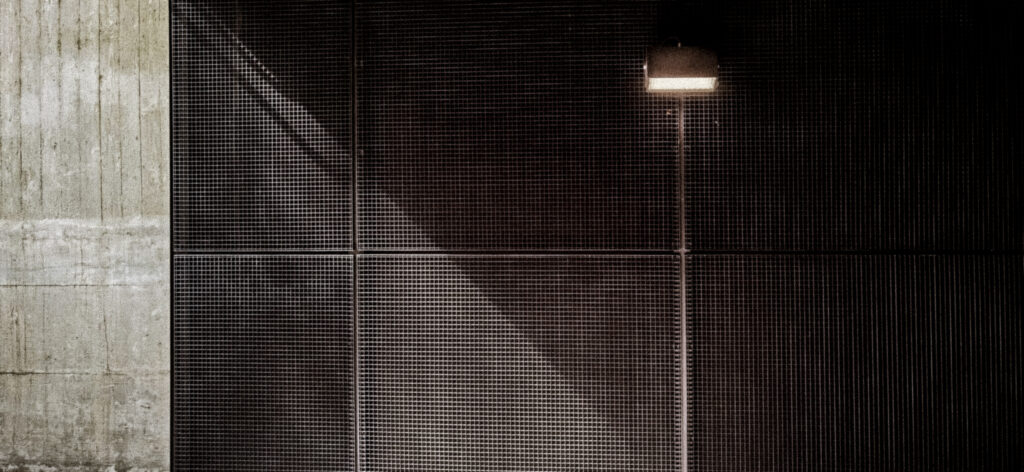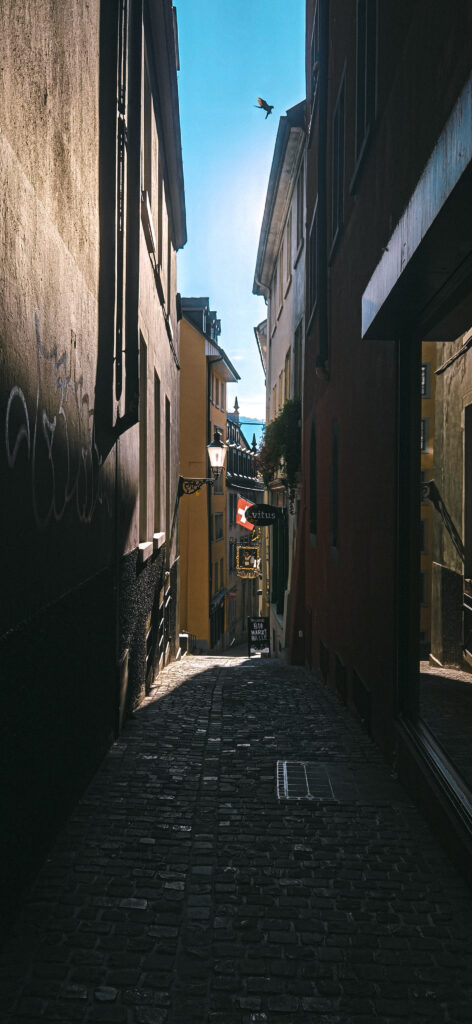Assignment 1
Space 1: ETH GLC Staircase

The space is situated in between the courtyard and the access to the building from Physikstrasse. The staircase is surrounded by black metal panels which creates a contrast to both ends of the stair which are opened up to all directions in a quite big matter.
Acoustics:
- There’s almost no reverberation, the metal panels – and the material behind them – seem to absorb sound quite intensely, leading to a very intimate atmosphere.
- The visual enclosure from open sky and wide courtyard to the small framed staircase is also noticable in the acoustics. The stereo field seems to get tightened up when entering.
- The frequency spectrum response of the sound doesn’t seem to be affected.
Space 2: Room between Parking lot and underground entrance to the Opera House Zurich

The room is very small – about 2-3m in width as well as in length – when both sliding doors are closed. It functions as a seperation space between the parking lot where car noise occurs and the underground lobby of the opera house in which opera music gets played.
Acoustics:
- When talking in a normal volume the room sounds as it looks. Not much reverberation going on and a boxy tone characterizes the sounds emitted.
- When raising the voice a subtle but long reverberation is noticable. The reverberation seems to return to sender from the light strips at the ceiling of the room.
Space 3: Ankergasse Zurich

The Ankergasse starts off very tightly and opens up to a court yard on the left side after the first building. All of the buildings are similarly high and share the plastered aesthetics of the walls.
Acoustics
- When speaking the sound feels amplified due to the enclosing of the nearby walls. There are no echoes nor long reverberations occuring and the tone of the voice feels very natural.
- Due to the open sky the space doesn’t feel as small since you still register sounds occuring in the sky and of the very lifely Münstergasse which is situated right behind the photo taken.
- When clapping or raising the voice, there is a reverberation with a tail of about 2 seconds. The thing that it made stand out to me is that this reverb feels very distant to the sound created as if the reverb gets stuck and fades out in the courtyard but not in the alley itself.
Assignment 2
SBB S11
Entering the train, acoustically feels like a changing of worlds once the doors look out the outside noises, there’s no longer any birds and car noises. The change of soundscape is getting announced with a wild BEEPING sound which is being played at every door as the Title song of each train ride. The doors close and the spectrum of sound gets split into what is going on inside of the train and outside. From the outside, an infinte loop of the train wheels on the track, which covers the most of the lower frequency spectrum, is played until one reaches his/her destination. The high frequencies get covered by the things happening on the inside of the train. Reggaeton beats bleeding through in-ear headphones from the left and drill beats from the right. The only thing that really bleed through – unless a fellow passanger plays his music in a very loud manner – are the snare and the cymbal of the drums. The few people, which aren’t occupied by doing stuff on their phone add sound of turning pages of the available “20 Minuten”. The next stop is getting announced: “SCHLIEREN”, which is followed by a PFFFFFF of the doors opening up and low frequencies of shoes which encounter the floor – of the wagon downstairs and upstairs in a damper way – desperately looking for a free spot to end in silence. Finally the repeating dembow rhythm from the left stops and starts fading into Bachata.
The surrounding sounds in a train makes me feel very lonely, which is odd since so many people are in there with me. The soundscape suggests that every person around me rather is spending time with themselves than with anybody. The headphones encapsules people into their own soundscape, whilst reading the papers takes over all of a persons focus. As a person doing neither of those activities it is a place that in every matter represents an “everyday routined life” which everyone lives for themselves.
ETH HIL E3 (Front-rows)
The voices of 200 people fill up the room, whilst non of them is really understandable unless you start chatting with the person next to you. The voices start to stop one by one when the bell rings. Now the loudened voice of the professor is only accompanied by a few whispering voices which are barely noticable and by fingers violating the keyboards placed beneath them. A few minutes into the lecture two other sounds are taking over the stage for very short moments. Once the fingers have got some time to rest over the keyboard they long for the crackling of paper bags to stop a person’s craving for food. And yet another sound is the short “PFF” of cans being popped open which helps to remain focused on the topic discussed. Suddenly, out of nowhere an annoying super high frequency BUZZING is taking over the ear which is stopping the use of the open can immediately as I instantly lose focus. Most probably it is caused by an electrical signal coming from some sort of device that is hidden somewhere in the room. After a few seconds the noise stops but it is certainly not gone for long.
The soundscape in a lecture hall gives off a strong community feeling. The feeling is not only communicated through chatting but also through the small acts of opening a El Tony can or the crackling of the bread bags of the coop which show that all of us seem to struggle with the same things.
Assignment 3
Guess:

Audacity Measuring:
Ankergasse: 0.7 s (initial tail from the room directly), 1.3 s (with the reverbtail of the bigger space next to the Ankergasse included)
Opera house: 0.88 s (as initial tail form the room directly), 2.8 s (with the reverbtail of the next room included)
Assignment 4
Space 1: ETH GLC Staircase
The entire Staircase is surrounded by the same black metal panels so I would assume that behind the metal layer everywhere is the same structure of the walls as well. Therefore – since the room sounds very dry – it supposes to me that an absorbing material is palced behind the panels, with an air gap in between.
The used material seems to absorb all of the frequencies (of the human voice) the same.
I don’t think that the intention of the material was to absorb sound but rather it is a side efffect of it (probably a heat insulating material which also is porous).
Space 2: Room between Parking lot and underground entrance to the Opera House Zurich
The room doesn’t have any acoustic treatments on the walls. All sides are rather reflective, yet the glass doors leak in sound and the reflections are less noticable than the ones of the concrete walls. Rather than hearing direct reflections of the glass, the reflections occuring in the next spaces are transported back in to the space as well.
The room in the front has sound absorbers placed on the ceiling. They give the ceiling a rough structure, which doesn’t implement into the context of the rest of the room. The absorbers do a good job in the higher frequencies, leaving the room with a boomy tone.
Since all the walls are parallel and not structured or curved in anyway, the sound doesn’t diffuse in the room.
Space 3: Ankergasse Zurich
There aren’t any absorbing materials placed. The space is surrounded by hard facades, which tend to reflect the sound a lot.
Maybe the ledges of the windows and the bending of the street add to the diffusion of the sound a bit.



